Identifying Corn Foliar Diseases; Timing of Fungicide Application; Safe Driving with Tall Crops
BY Dairyland Seed Agronomy Team
5 KEY CORN FOLIAR DISEASES IN THE UPPER MIDWEST
Anthracnose Leaf Blight
Oval-shaped lesions that start as water-soaked impressions and progress to tan centers with reddish-brown margins. Symptoms will begin in the lower canopy and move up the plant. Lesions can grow to several inches in length and join to completely kill a leaf. Though caused by the same pathogen, anthracnose stalk rot infection is independent of the leaf blight. The two versions may or may not occur simultaneously.
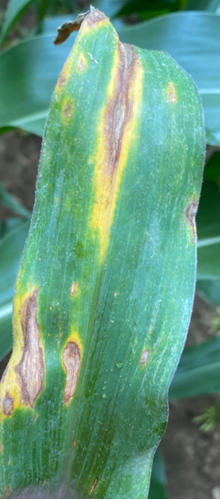
Anthracnose Leaf Blight
Gray Leaf Spot
Lesions of this disease are named after gray spores that are released as the fungus matures. Perhaps a more defining feature is the shape. The fungus is contained by the leaf veins of the plant, so it maintains a straight edge appearance with squared ends. Legions can be ½”-4” long.
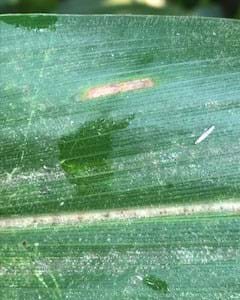
Gray Leaf Spot
Tar Spot:
Tar Spot is creating a lot of buzz these days, and for good reason. It can progress quickly and it has a polycyclic lifecycle, which means that it can reproduce over and over in one season if conditions are right. Identification is relatively easy after you see is once. The black spots will appear as splattered paint. The “tar” reference is likely from the fact that the spots cannot be wiped off the leaf, which is the main differentiator from basic insect frass. As the disease progresses, halos of necrotic plant tissue will form around the black spots.
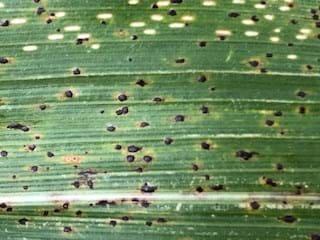
Tar Spot: note early halo development
Goss’s Wilt:
Goss’s wilt is the only bacterial disease on this list, and therefore cannot be controlled with a fungicide. Mature plants that are infected will have wavy leaf margins and dark green to black freckles which are better observed against sunlight.

Goss's Wilt
Northern Corn Leaf Blight:
NCLB symptoms are long cigar-shaped lesions that range from 1-6” long. Typical progression through the plant is from bottom to top. As with other-diseases, lesions can progress to killing leaf material. This disease can look very similar to anthracnose leaf blight, but will not be as irregular in shape.
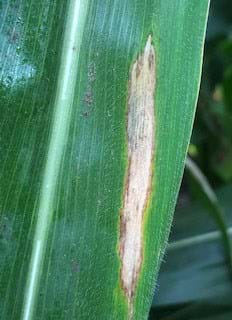
Northern Corn Leaf Blight
FUNGICIDE TIMING
Corn
Recommended fungicide application timing on corn is VT (tasseling) to R2 (blister or brown silk). We recommend beginning applications once 75-80 percent of tassels are visible. Some products allow for an earlier application of pre-tassel, but the VT to R2 window has shown the most consistent control of mid to late season foliar diseases. Tar spot has been confirmed in parts of the Dairyland footprint and Grey Leaf Spot along with Northern Leaf Blight usually settle in around pollination.
In many areas Tar Spot has not appeared in corn….yet. The period of time between disease infection and symptomatology in Tar Spot is around 20 days, most areas had conducive weather for infection of Tar Spot within the last 20 days. Application timing for Tar Spot control in areas of no symptoms at this time should take place at Brown Silk. Applications of fungicide at Brown Silk allow for disease suppression well into grain fill, most residual windows for these products last between 14 and 21 days.
Soybeans
Recommended fungicide application timing for soybeans is R2 to R3. A soybean is in R2 when an open flower is visible on one of the top two nodes on the main stem. The soybean has matured to R3 when a 3/16in long pod can be found on one of the four top nodes on the main stem. Fungicide applications at R3 have shown to provide the most consistent control of mid to late season diseases such as Frogeye thought pod and seed development.
Product Recommendations
There are many high-quality fungicides available to us today. Best management practices dictate that we do our best to negate resistance. As stated above, resistance to certain fungicides has already been found and in our past experience with weed resistance we know that applications of multiple modes of action allow us to use the tools we have for a longer period of time before resistance occurs. We recommend the use of approved fungicides with multiple modes of action with adequate water volumes to ensure coverage this improves the efficacy of the fungicide and helps to mitigate resistance.
TALL CROPS AND DRIVING SAFELY
In areas that have received moisture in adequate amounts, we have crops that are growing rapidly and getting tall, which is a good thing. The safety issue that arises from our corn, alfalfa or soybeans growing so tall is that they tend to obstruct the view as we are driving and are coming up to curves, approaches or intersections. Because we drive our township roads or prairie trails frequently, we may become used to the crop size and not fully realize how much of our view is really obstructed by our growing crops.
The take home message from this is to remember to slow down and take a little more time as we come up to curves, field approaches or intersections. This may also be a good time to remind some of our younger or less seasoned drivers to make a point of slowing down and coming to full stops at intersections due to the height of the crop and how much their view has changed.
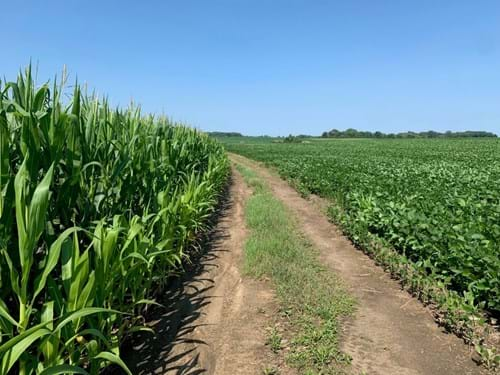
 |
 |
 |
 |
 |
| Brian Weller Western Region 507.456.3034 |
Dan Ritter Central Region 219.863.0583 |
Branden Furseth Northern Region 608.513.4265 |
Mark Gibson Eastern Region 260.330.8968 |
Amanda Goffnett Eastern Region 989.400.3793 |
